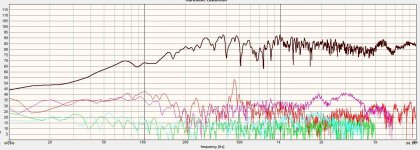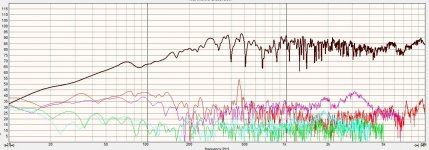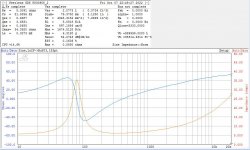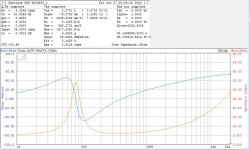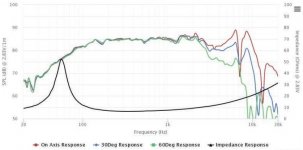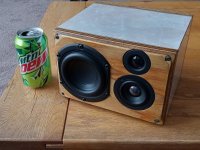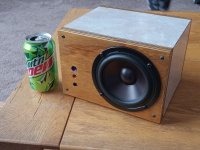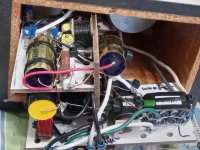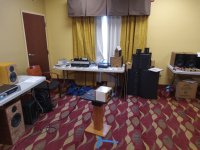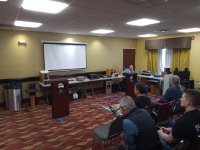I owe NickS (Ugly Woofer) for the light bulb on the name. He said they 'resemble putting a ship in a bottle'. Mix with Battleship, and voila!
So, if you thought the Purveyor were small, these are shoehorned into HALF that volume. You likely now think I've sincerely lost my mind. These are the smallest 3ways I've both seen and heard (of) in DIY circles. The Purveyor were 5.25"/2.5"/1.0" arrangement, and the new 'ships are 4"/2"/0.75". There is no way a 5.25" woofer would fit and perform well in a total of 3.5 ltrs, nor will the drivers fit on the baffle without using a 4" or smaller woofer. If I want the bass extension, a 3" with good bass performance would be too low in sensitivity for my requirements, so a 4" it has to be. Next problem is that the number of 4" with great bass performance is even fewer than that of the 5.25" pool of options. I settled on the Peerless SDS 830855, $19 at PE, and a supposed 86dB sensitivity. The obvious next choice is that of a 5.25" PR to align the stars for the best maiden voyage into bass dredging. (Looking around, I feel that the Dayton TCP115-4 could be a viable woofer substitution with some xover rework, as long as it fits on the baffle.)
So, putting this info above into practical use, the mid I decided on is the Audible Physics 220CP1 8ohm from Newark/Farnell for $22. It's a carbon paper cone with an aluminum dustcap, cast frame, 86dB sensitivity, and a large Neo motor. Being that Chuck (isaeagle1031) and others have really liked the AP stuff, so I didn't even second guess my choice at the cheap price per. I had to try it after seeing it in Brandon's thread a little while ago. I fiddled around with 4-5 different chamber arrangements empirically modeling and physically testing them until I came upon another of my 'ice-cream sandwich' type alignments, or Multichambered Aperiodic sealed; AKA MAPD from Northcreek fame. Being a 2", and being primarily used from 700Hz+ as an estimate, the amount of volume required is small. However, the Fs magnitude and frequency is fairly high and could stand to be minimized a bit to aid in xover simplicity and damping of the rolloff. Using a 2" PVC coupler and endcap, a 1.5"-2" adapter, 2 equal pieces of Bonded Logic or Ultra Touch, a ring of wool batting, and a bit of E6000 adhesive; sufficed for a 0.13 ltr chamber.
Further on the boxes... Being of minimal midrange volume, this lent the woofer volume to be ~3.2 ltrs. Using the DSA135 PR without added mass models to Fb/3/10 of 60/68/48Hz, or a very gradual rolloff. Trying to conserve sensitivity, using a steel-laminate coil creates a bump in response around the Fs of the woofer of a dB or two. Then using a 730uF Passive Assist capacitor in combination with the highish Fs and the higher Q of a vented box, while gaining another order on the rolloff, actually also extends the lowend a smidge here. (I have a HUGE box of 330uF polarized caps, and I have been making large NPE caps with them for awhile now.)
I am using the Dayton ND20FA-6 because I have them, and it fits atop the mid on the baffle. They are tiny, but look big on these small speakers. The main positioning of the drivers on the baffle actually involves the midrange chamber as the most influential information. Acoustic offsets are at 2" from midrange to tweeter, and 4" from midrange to woofer. Unfortunately, this also means that the truncated Peerless MUST be mounted vertically to get everything to fit.
The xover as modeled and refined represents 17 individual components. I can hear the gasping and see the whites of your eyes now.... In this portion I am using the smaller and cheaper parts I've acquired over the years, like 22AWG coils for the tweeter and midrange shunts, small mylar caps, and as few resistors as possible. "How you gonna fit all that $#!+ in that tiny box, dude!?" was the usual reply in conversation with the closest of you.
Well- it ended up requiring a 3D xover pegboard assembly. I've thought of doing this before, and have done daughter boards before a few times but never to this nth degree. It almost operates as a brace that press-fits vertically inside.
Now, a lot of you are likely thinking, "Why!? would you have a 3way with a 4" woofer?" The initial goal was to use the AP mid or any 2" mid effectively. Going further, the tweeter is good to 4kHz before HD rises. The AP has HD above 1% below the 750-800Hz region. The 830855 has dominant 3rd order HD above about 1.2kHz, even though it does not rise above 1% in amplitude. According to these frames of reference, it makes sense why the HD would be lower or better for these particular drivers utilized together.
The mid takes #4 flush-head screws as the mounting holes are beveled. I bought some torx head "for plastic" screws that worked really nicely. The woofer/PR have #8 torx sheet metal screws. The tweeter is press fit and sealed with E6000 on the back. Woofer inside edge is beveled. To speed up the process, I used a self-selected hole saw set that I accumulated last year for Christmas. The largest is a 4.125" diameter for common tweeter faces. Cutting the perimeter of the rebates is the hardest part, then the remaining area can be removed swiftly with the trim router. It takes less time in setup and making the cuts than a full router solution for me. However, a router rabbet bearing set is also a valid counterpart to the hole saws.
The finish is 2-3 coats of Watco Danish Oil, then Minwax Golden Oak stain. Being the grain is a bit open, I did something different this time. I used Permatex black silicone to cover the surface, and then slowly wiped off the excess. After that dried, I steel wooled the surface to remove the crumbs and excessive bits. Then a coat of polyurethane finished the front and back off. The chatoyance is pretty nice, and I really like the edge look. The main box section is built with pre-formica'd 3/4" particle board. I used full mitered corners for the finished assembly, and coated with epoxy for strength and durability.
The inputs are rear mounted binding posts that did not have the front nut to clamp down. I grabbed a bag a couple years ago at a DIY event. Basically, I drilled a 19/64" hole, recess the entrance from the rear so it's closer to the front, and lightly beveled the front entrance. Then I sealed it with E6000 to be air tight and keep it strong. I even made/altered a custom socket to drive them from an 11/32" Craftsman deep well socket as I have a LOT of them. I apply solder to the tips to pre-tin them, reheat and insert the wire. Why the 3 terminals? I planned on measuring the difference nearfield with and without the 730uF in play. The Blue terminal is direct to the lowpass coil and bypasses this cap whereas the red terminal is input to the 730uF capacitor bundle. I can just move the banana plug and use it the other way.
How do they sound? These are actually really impressive WITHOUT the big cap. With was okay, but has some insertion loss for sure.
I could take them to -10 on the preamp to where they started to complain a bit without the cap engaged. There doesn't seem to be much difference in spectral balance with the cap though. They really can kick up a storm in the bass too. For damping, I have a roll of wool batting wedged between the woofer and PR. The mids are really nice and clean, and the tweeter does an admiral job in its bandwidth with low HD to boot. I think the PR is barely capable of being pummeled by this Peerless woofer. It puts up with it, but likely to the peak of its performance at higher levels.
Tuning was supposed to be 60Hz in modeling, but measured at 50Hz. Not really sure how this happened. I only have the dinky supplied washer and bolt that came with the PRs attached to the mounting hole. Maybe the Mms on these units was higher than spec, or the volume somehow is larger than modeled- and I know if anything it's less volume. This yields an F3/10 of 80/42Hz, and that is not really all that bad. Bass sounds great for a 4" design.
Initial measurements showed a dip at 718Hz and 150Hz. I knew the 150 was likely floor bounce, and ignored it. Modelling the highpass cap doubled indicated that the higher dip might fill in, and it was still present off axis. After this complying modification, I measured higher from the floor, and the dip shifted to 525Hz. The 150 dip disappeared. However, the HD is still good and the upper dip is gone. Fullness was perceived as better on the bottom of the midrange than before. Xover points became 900/4k Hz.
I'll have to separate this in a few posts to get it all up here...
Thanks for looking!
Wolf
Edit: The purple dims in mm in the drawing are for supposed acoustic Z offsets. These do not represent the dimensions of the drivers.
So, if you thought the Purveyor were small, these are shoehorned into HALF that volume. You likely now think I've sincerely lost my mind. These are the smallest 3ways I've both seen and heard (of) in DIY circles. The Purveyor were 5.25"/2.5"/1.0" arrangement, and the new 'ships are 4"/2"/0.75". There is no way a 5.25" woofer would fit and perform well in a total of 3.5 ltrs, nor will the drivers fit on the baffle without using a 4" or smaller woofer. If I want the bass extension, a 3" with good bass performance would be too low in sensitivity for my requirements, so a 4" it has to be. Next problem is that the number of 4" with great bass performance is even fewer than that of the 5.25" pool of options. I settled on the Peerless SDS 830855, $19 at PE, and a supposed 86dB sensitivity. The obvious next choice is that of a 5.25" PR to align the stars for the best maiden voyage into bass dredging. (Looking around, I feel that the Dayton TCP115-4 could be a viable woofer substitution with some xover rework, as long as it fits on the baffle.)
So, putting this info above into practical use, the mid I decided on is the Audible Physics 220CP1 8ohm from Newark/Farnell for $22. It's a carbon paper cone with an aluminum dustcap, cast frame, 86dB sensitivity, and a large Neo motor. Being that Chuck (isaeagle1031) and others have really liked the AP stuff, so I didn't even second guess my choice at the cheap price per. I had to try it after seeing it in Brandon's thread a little while ago. I fiddled around with 4-5 different chamber arrangements empirically modeling and physically testing them until I came upon another of my 'ice-cream sandwich' type alignments, or Multichambered Aperiodic sealed; AKA MAPD from Northcreek fame. Being a 2", and being primarily used from 700Hz+ as an estimate, the amount of volume required is small. However, the Fs magnitude and frequency is fairly high and could stand to be minimized a bit to aid in xover simplicity and damping of the rolloff. Using a 2" PVC coupler and endcap, a 1.5"-2" adapter, 2 equal pieces of Bonded Logic or Ultra Touch, a ring of wool batting, and a bit of E6000 adhesive; sufficed for a 0.13 ltr chamber.
Further on the boxes... Being of minimal midrange volume, this lent the woofer volume to be ~3.2 ltrs. Using the DSA135 PR without added mass models to Fb/3/10 of 60/68/48Hz, or a very gradual rolloff. Trying to conserve sensitivity, using a steel-laminate coil creates a bump in response around the Fs of the woofer of a dB or two. Then using a 730uF Passive Assist capacitor in combination with the highish Fs and the higher Q of a vented box, while gaining another order on the rolloff, actually also extends the lowend a smidge here. (I have a HUGE box of 330uF polarized caps, and I have been making large NPE caps with them for awhile now.)
I am using the Dayton ND20FA-6 because I have them, and it fits atop the mid on the baffle. They are tiny, but look big on these small speakers. The main positioning of the drivers on the baffle actually involves the midrange chamber as the most influential information. Acoustic offsets are at 2" from midrange to tweeter, and 4" from midrange to woofer. Unfortunately, this also means that the truncated Peerless MUST be mounted vertically to get everything to fit.
The xover as modeled and refined represents 17 individual components. I can hear the gasping and see the whites of your eyes now.... In this portion I am using the smaller and cheaper parts I've acquired over the years, like 22AWG coils for the tweeter and midrange shunts, small mylar caps, and as few resistors as possible. "How you gonna fit all that $#!+ in that tiny box, dude!?" was the usual reply in conversation with the closest of you.
Well- it ended up requiring a 3D xover pegboard assembly. I've thought of doing this before, and have done daughter boards before a few times but never to this nth degree. It almost operates as a brace that press-fits vertically inside.
Now, a lot of you are likely thinking, "Why!? would you have a 3way with a 4" woofer?" The initial goal was to use the AP mid or any 2" mid effectively. Going further, the tweeter is good to 4kHz before HD rises. The AP has HD above 1% below the 750-800Hz region. The 830855 has dominant 3rd order HD above about 1.2kHz, even though it does not rise above 1% in amplitude. According to these frames of reference, it makes sense why the HD would be lower or better for these particular drivers utilized together.
The mid takes #4 flush-head screws as the mounting holes are beveled. I bought some torx head "for plastic" screws that worked really nicely. The woofer/PR have #8 torx sheet metal screws. The tweeter is press fit and sealed with E6000 on the back. Woofer inside edge is beveled. To speed up the process, I used a self-selected hole saw set that I accumulated last year for Christmas. The largest is a 4.125" diameter for common tweeter faces. Cutting the perimeter of the rebates is the hardest part, then the remaining area can be removed swiftly with the trim router. It takes less time in setup and making the cuts than a full router solution for me. However, a router rabbet bearing set is also a valid counterpart to the hole saws.
The finish is 2-3 coats of Watco Danish Oil, then Minwax Golden Oak stain. Being the grain is a bit open, I did something different this time. I used Permatex black silicone to cover the surface, and then slowly wiped off the excess. After that dried, I steel wooled the surface to remove the crumbs and excessive bits. Then a coat of polyurethane finished the front and back off. The chatoyance is pretty nice, and I really like the edge look. The main box section is built with pre-formica'd 3/4" particle board. I used full mitered corners for the finished assembly, and coated with epoxy for strength and durability.
The inputs are rear mounted binding posts that did not have the front nut to clamp down. I grabbed a bag a couple years ago at a DIY event. Basically, I drilled a 19/64" hole, recess the entrance from the rear so it's closer to the front, and lightly beveled the front entrance. Then I sealed it with E6000 to be air tight and keep it strong. I even made/altered a custom socket to drive them from an 11/32" Craftsman deep well socket as I have a LOT of them. I apply solder to the tips to pre-tin them, reheat and insert the wire. Why the 3 terminals? I planned on measuring the difference nearfield with and without the 730uF in play. The Blue terminal is direct to the lowpass coil and bypasses this cap whereas the red terminal is input to the 730uF capacitor bundle. I can just move the banana plug and use it the other way.
How do they sound? These are actually really impressive WITHOUT the big cap. With was okay, but has some insertion loss for sure.
I could take them to -10 on the preamp to where they started to complain a bit without the cap engaged. There doesn't seem to be much difference in spectral balance with the cap though. They really can kick up a storm in the bass too. For damping, I have a roll of wool batting wedged between the woofer and PR. The mids are really nice and clean, and the tweeter does an admiral job in its bandwidth with low HD to boot. I think the PR is barely capable of being pummeled by this Peerless woofer. It puts up with it, but likely to the peak of its performance at higher levels.
Tuning was supposed to be 60Hz in modeling, but measured at 50Hz. Not really sure how this happened. I only have the dinky supplied washer and bolt that came with the PRs attached to the mounting hole. Maybe the Mms on these units was higher than spec, or the volume somehow is larger than modeled- and I know if anything it's less volume. This yields an F3/10 of 80/42Hz, and that is not really all that bad. Bass sounds great for a 4" design.
Initial measurements showed a dip at 718Hz and 150Hz. I knew the 150 was likely floor bounce, and ignored it. Modelling the highpass cap doubled indicated that the higher dip might fill in, and it was still present off axis. After this complying modification, I measured higher from the floor, and the dip shifted to 525Hz. The 150 dip disappeared. However, the HD is still good and the upper dip is gone. Fullness was perceived as better on the bottom of the midrange than before. Xover points became 900/4k Hz.
I'll have to separate this in a few posts to get it all up here...
Thanks for looking!
Wolf
Edit: The purple dims in mm in the drawing are for supposed acoustic Z offsets. These do not represent the dimensions of the drivers.
Attachments
-
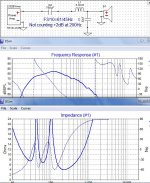 830855_Passive Assist.jpg102.6 KB · Views: 635
830855_Passive Assist.jpg102.6 KB · Views: 635 -
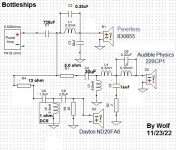 BottleshipsXoverSim1.jpg104.1 KB · Views: 699
BottleshipsXoverSim1.jpg104.1 KB · Views: 699 -
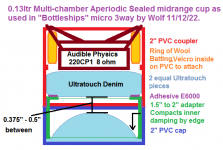 MAPD mid chamber for Bottleships.png11.5 KB · Views: 814
MAPD mid chamber for Bottleships.png11.5 KB · Views: 814 -
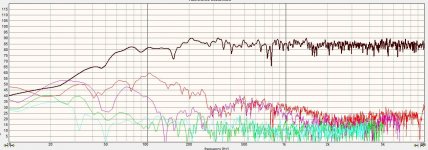 BottleshipsRight_+15uF_HD_11-22-22.jpg113.8 KB · Views: 585
BottleshipsRight_+15uF_HD_11-22-22.jpg113.8 KB · Views: 585 -
 BottleshipsRight_+15uF_1-24th_11-22-22.jpg65.6 KB · Views: 462
BottleshipsRight_+15uF_1-24th_11-22-22.jpg65.6 KB · Views: 462 -
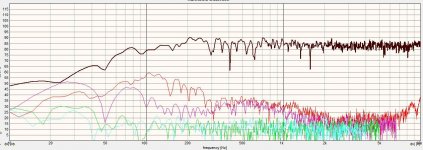 BottleshipsLeft_+15uF_HD_11-22-22.jpg115.3 KB · Views: 444
BottleshipsLeft_+15uF_HD_11-22-22.jpg115.3 KB · Views: 444 -
 BottleshipsLeft_+15uF_1-24th_11-22-22.jpg66.4 KB · Views: 617
BottleshipsLeft_+15uF_1-24th_11-22-22.jpg66.4 KB · Views: 617 -
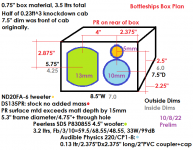 BottleshipsBox2.png16.6 KB · Views: 629
BottleshipsBox2.png16.6 KB · Views: 629 -
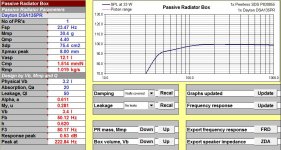 Bottleships_FbMeasured_RemodeledBox.jpg101.9 KB · Views: 668
Bottleships_FbMeasured_RemodeledBox.jpg101.9 KB · Views: 668
Last edited:
Woofer data below...
I altered the woofer FR plot as it was incorrect, and it was not as good as it could have been. Due to this, the initial woofer FR data was from manufacturer's spec sheets, adapted to the box in question.
I altered the woofer FR plot as it was incorrect, and it was not as good as it could have been. Due to this, the initial woofer FR data was from manufacturer's spec sheets, adapted to the box in question.
Attachments
Midrange data:
Attachments
-
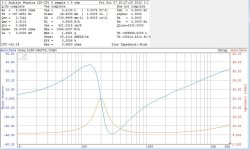 220CP1-1.jpg84.4 KB · Views: 197
220CP1-1.jpg84.4 KB · Views: 197 -
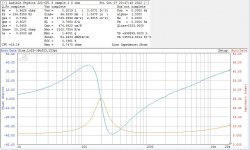 220CP1-2.jpg81.7 KB · Views: 188
220CP1-2.jpg81.7 KB · Views: 188 -
 AP220CP1_LeftBottleship_tweeterAxis.jpg71.1 KB · Views: 178
AP220CP1_LeftBottleship_tweeterAxis.jpg71.1 KB · Views: 178 -
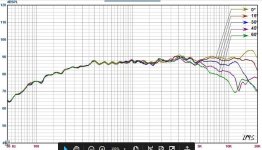 220CP1Spec.jpg118.1 KB · Views: 185
220CP1Spec.jpg118.1 KB · Views: 185 -
 AudiblePhysics220CP1_OnRightTweeterAxisBottleships.jpg67.1 KB · Views: 174
AudiblePhysics220CP1_OnRightTweeterAxisBottleships.jpg67.1 KB · Views: 174 -
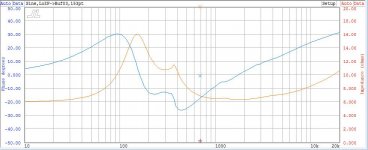 MAPD-Mid-Attempt4.jpg49.9 KB · Views: 158
MAPD-Mid-Attempt4.jpg49.9 KB · Views: 158 -
 AudiblePhysics 220CP1_OnAxis_0pt13ltrsLeftBottleships.jpg74.1 KB · Views: 159
AudiblePhysics 220CP1_OnAxis_0pt13ltrsLeftBottleships.jpg74.1 KB · Views: 159 -
 AudiblePhysics 220CP1_OnAxis_0pt13ltrsRightBottleships.jpg70.6 KB · Views: 171
AudiblePhysics 220CP1_OnAxis_0pt13ltrsRightBottleships.jpg70.6 KB · Views: 171 -
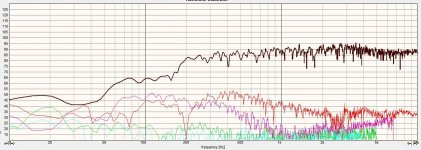 AudiblePhysics 220CP1_OnAxisHDRightBottleships.jpg111.1 KB · Views: 168
AudiblePhysics 220CP1_OnAxisHDRightBottleships.jpg111.1 KB · Views: 168 -
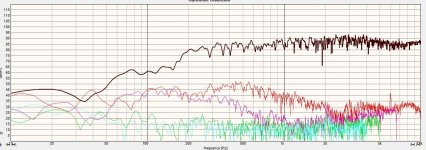 AudiblePhysics 220CP1_OnAxisLeftBottleshipsHD.jpg115.5 KB · Views: 189
AudiblePhysics 220CP1_OnAxisLeftBottleshipsHD.jpg115.5 KB · Views: 189
Tweeter data...
Of note- the units I have do not exhibit the top-octave rolloff shown in the data sheet for these.
Of note- the units I have do not exhibit the top-octave rolloff shown in the data sheet for these.
Attachments
-
 DaytonND20FA6_onAxis_LeftBottleShips.jpg63.3 KB · Views: 170
DaytonND20FA6_onAxis_LeftBottleShips.jpg63.3 KB · Views: 170 -
 ND20FA6Spec.jpg40 KB · Views: 155
ND20FA6Spec.jpg40 KB · Views: 155 -
 ND20FA6_2.jpg78.9 KB · Views: 140
ND20FA6_2.jpg78.9 KB · Views: 140 -
 ND20FA6_1.jpg78.2 KB · Views: 163
ND20FA6_1.jpg78.2 KB · Views: 163 -
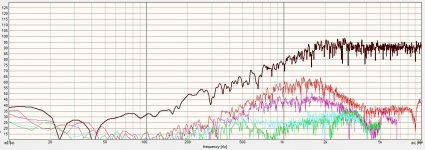 DaytonND20FA6_OnRightTweeterAxisBottleshipsHD.jpg112 KB · Views: 160
DaytonND20FA6_OnRightTweeterAxisBottleshipsHD.jpg112 KB · Views: 160 -
 DaytonND20FA6_OnRightTweeterAxisBottleships.jpg64.4 KB · Views: 165
DaytonND20FA6_OnRightTweeterAxisBottleships.jpg64.4 KB · Views: 165 -
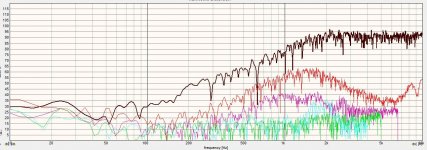 DaytonND20FA6_onAxisLeftBottleshipsHD.jpg119.9 KB · Views: 168
DaytonND20FA6_onAxisLeftBottleshipsHD.jpg119.9 KB · Views: 168
Final impedance minimum is 3.8 ohms at 150Hz. I forgot to state that earlier.
Attachments
-
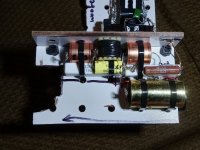 3fqdkf4na10v.jpg175.9 KB · Views: 456
3fqdkf4na10v.jpg175.9 KB · Views: 456 -
 7bax8l50anif.jpg231.6 KB · Views: 448
7bax8l50anif.jpg231.6 KB · Views: 448 -
 65v0871bmzxa.jpg179.8 KB · Views: 430
65v0871bmzxa.jpg179.8 KB · Views: 430 -
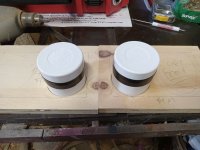 amw727om84hb.jpg192 KB · Views: 638
amw727om84hb.jpg192 KB · Views: 638 -
 arvvtjitoquo.jpg161.7 KB · Views: 618
arvvtjitoquo.jpg161.7 KB · Views: 618 -
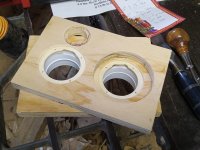 djdo8b86pgln.jpg204.8 KB · Views: 625
djdo8b86pgln.jpg204.8 KB · Views: 625 -
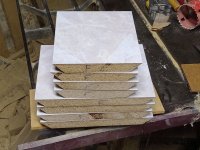 e4m5joq8cu35.jpg226.7 KB · Views: 476
e4m5joq8cu35.jpg226.7 KB · Views: 476 -
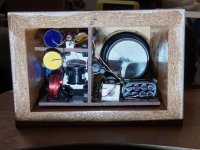 fmexhmwu74ab.jpg213.4 KB · Views: 485
fmexhmwu74ab.jpg213.4 KB · Views: 485 -
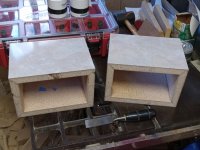 jejc6lb4gchf.jpg187.1 KB · Views: 464
jejc6lb4gchf.jpg187.1 KB · Views: 464 -
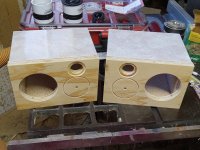 n4abe45g033z.jpg226.7 KB · Views: 428
n4abe45g033z.jpg226.7 KB · Views: 428 -
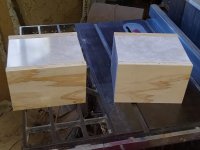 w4m7zf9dku8p.jpg152.6 KB · Views: 442
w4m7zf9dku8p.jpg152.6 KB · Views: 442 -
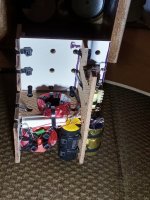 tgp4wdnpgoum.jpg392.9 KB · Views: 452
tgp4wdnpgoum.jpg392.9 KB · Views: 452
Just did some beating on these, and they really are quite a capable little design. The realism from the mid/tweet is really really good. Air blown pipes or rain sound very realistic. Upper electric bass is rendered well, and kick comes through very solid.
I really feel if there was a curtain in front of them, and you had no idea what you were hearing, that your jaw would hit the floor when they were revealed. Clarity is good and soundstage is just massive from these tiny things. Weight and spectral balance is also good with little fatigue.
The main flaw appears to be the rendering of ultra complex music where it seems the mid to woofer blending could become blurred or congested at higher levels. That said, it depends on program material and seems to not be a common occurence.
I really feel if there was a curtain in front of them, and you had no idea what you were hearing, that your jaw would hit the floor when they were revealed. Clarity is good and soundstage is just massive from these tiny things. Weight and spectral balance is also good with little fatigue.
The main flaw appears to be the rendering of ultra complex music where it seems the mid to woofer blending could become blurred or congested at higher levels. That said, it depends on program material and seems to not be a common occurence.
Wolf,
some questions,
1) How does the Audible Physics sound by itself vs with the tweeter or vs other fullrange drivers ie TC9fd ?
2) Is the Audible Physics graph fairly accurate?
3) What do think of a skinny 3 way or mini tarkus style speaker? (Peerless 830656)
33 inches / 84 cm ht
https://quint-store.com/lautsprecher-bausaetze/standlautsprecher/starter-3-way
33.5 inches / 85 cm ht
https://totemacoustic.com/product/arro/
I know this is getting away from the original design. I was studying your Purveyor and thought that was small. This new one is quite impressive.
Thank You, Chris
some questions,
1) How does the Audible Physics sound by itself vs with the tweeter or vs other fullrange drivers ie TC9fd ?
2) Is the Audible Physics graph fairly accurate?
3) What do think of a skinny 3 way or mini tarkus style speaker? (Peerless 830656)
33 inches / 84 cm ht
https://quint-store.com/lautsprecher-bausaetze/standlautsprecher/starter-3-way
33.5 inches / 85 cm ht
https://totemacoustic.com/product/arro/
I know this is getting away from the original design. I was studying your Purveyor and thought that was small. This new one is quite impressive.
Thank You, Chris
The AP could likely be used with a woofer only and be just fine if that is the builder's preference. The off axis would suffer a bit on top. I would not use it below 750 to keep it happy. I think I prefer the AP over the TC9, but the TC9 may play a little lower if needed.
2 of the FR plots in the midrange data post are on axis, the other 2 are on the tweeter axis. That should show you what you need to know there.
I don't think a conventionally stacked 3way would be out of the question, but volumes and box models will need adjustment. However, this would likely work well as you suppose.
2 of the FR plots in the midrange data post are on axis, the other 2 are on the tweeter axis. That should show you what you need to know there.
I don't think a conventionally stacked 3way would be out of the question, but volumes and box models will need adjustment. However, this would likely work well as you suppose.
However, with a xover at 750, the woofer should be a lot closer to the midrange for best results.
Member
Joined 2009
Paid Member
Agreed!Very cool, most impressed how you shoe horned the crossover in there.
As a thought experiment, if tri-amped with a line level crossover there would be no need to cram those parts into the box and there could be a performance improvement.
True, but then it would not be plug n play, nor would the amplifiers be able to fit into the box. I sort of have a rule that active ain't worth it if the amps can't be integrated internally.
The point was a fully functional micro 3way, that stands on its own, is all inside the box, and half the volume of the previous small 3way I did.
I'm not an active xover guy, and prefer passive in application, 99% of the time. I've listened to a lot of both, and active by DSP has never been absolutely better than passive. Attenuate and boost is not all that is required in some designs.
The point was a fully functional micro 3way, that stands on its own, is all inside the box, and half the volume of the previous small 3way I did.
I'm not an active xover guy, and prefer passive in application, 99% of the time. I've listened to a lot of both, and active by DSP has never been absolutely better than passive. Attenuate and boost is not all that is required in some designs.
It's really stunning how you've managed to cram everything into such a small box. Had you considered the Dayton 4-way DSP/amp boards? Quality aside they look smaller than that crossover. I'm imagining having to calculate the crossover displacement volume in a sealed box because it's so small.
wolf_teeth,
Bravo! I missed this one earlier - just saw today. Daring project to make a 3 way so small, and looks like you've pulled it off in style. 🙂
Bravo! I missed this one earlier - just saw today. Daring project to make a 3 way so small, and looks like you've pulled it off in style. 🙂
This little speaker was one of the most impressive showings at the recent InDIYana event. It sounded so good, so big, and it is so so so tiny. Especially impressive is that it was put together from drivers of modest cost. Nice Job !
j.
j.
Thanks, Jim! I really like these little boogers, and feel a lot of people there did too.
For a demonstration, initially these were on the table up front. I figured they needed the help in that room being so large. They were chesty enough that I had to relocate them to the common stand position. At home I use them about 2' from the front wall.
They held their own!
You can see them behind the "Portals" by DanP and NickS in the one photo. They are on the stands by themselves in the other.
For a demonstration, initially these were on the table up front. I figured they needed the help in that room being so large. They were chesty enough that I had to relocate them to the common stand position. At home I use them about 2' from the front wall.
They held their own!
You can see them behind the "Portals" by DanP and NickS in the one photo. They are on the stands by themselves in the other.
Attachments
- Home
- Loudspeakers
- Multi-Way
- "Bottleships"; The smallest DIY 3-ways I've built or seen...
